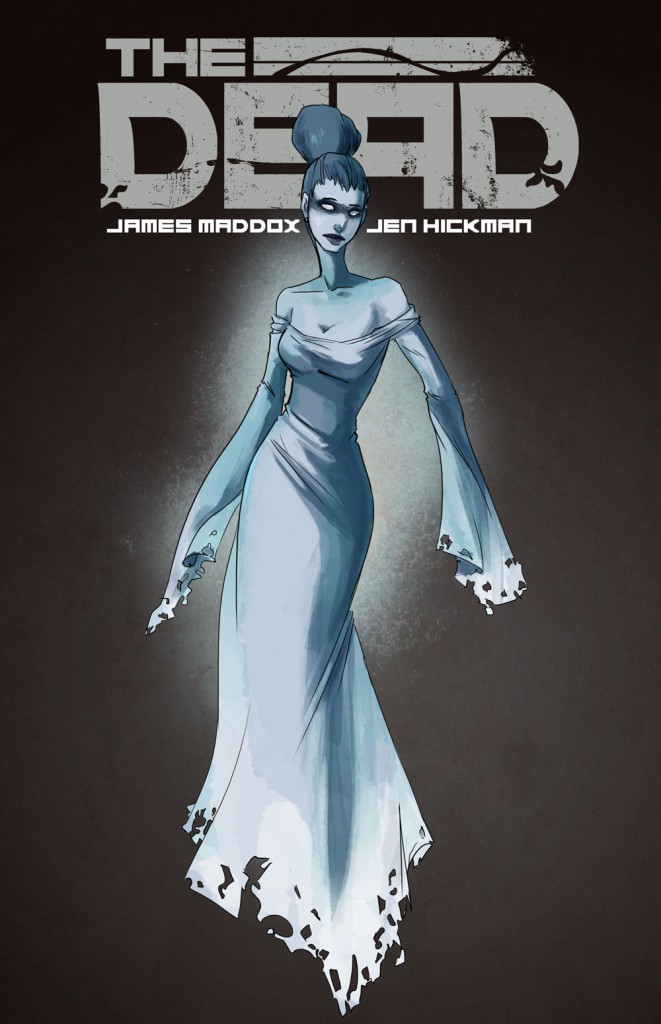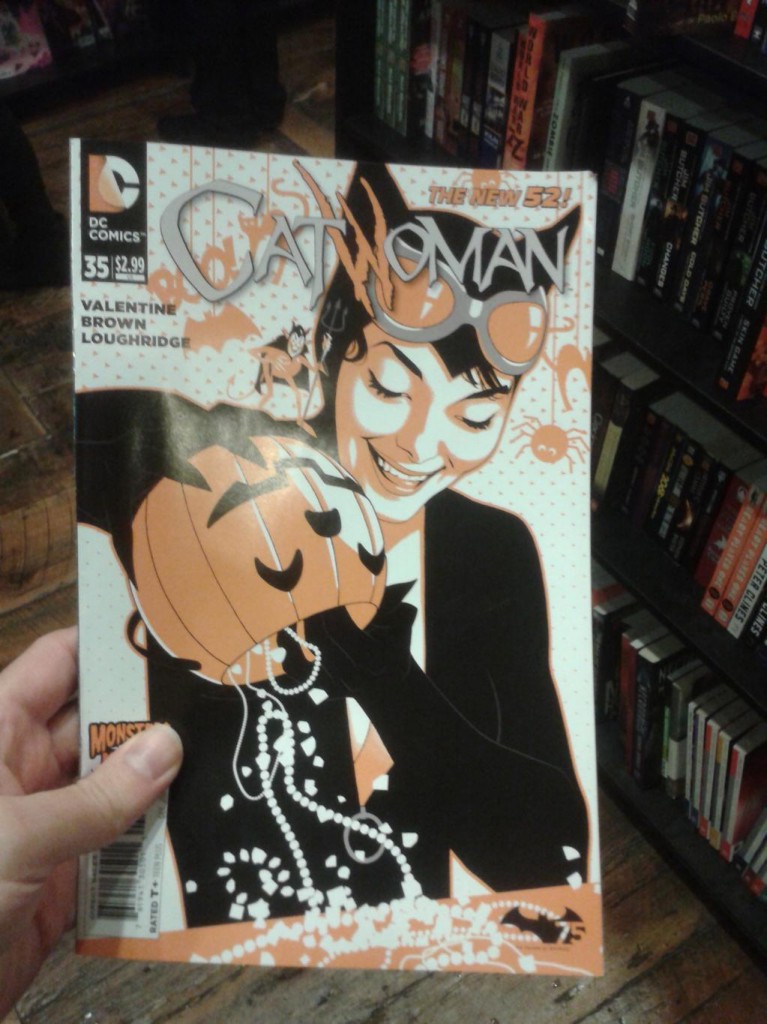
Welcome to the inaugural edition of The Scariest Part, a new, recurring feature in which authors, comic book writers, filmmakers, and game creators tell us what scares them in their latest works of horror, dark fantasy, dark science fiction, and suspense. I’m thrilled to have James Maddox and Jen Hickman as my first guests. Together, they’re the creators behind the ongoing digital comic The Dead. Currently, they’re also running a Kickstarter campaign to fund a graphic novel print version of the comic. Here’s a description of the series:
When Sam opens his eyes after dying, he expects to see heavenly clouds or hellfire. What he’s faced with instead is “The House” – a surreal and often-dangerous afterlife of interconnected rooms. As Sam travels deeper into this new world, he finds the strange creators of these rooms aren’t the only residents of The House. Here there be monsters, and if he isn’t careful, Sam’s stay will take a horrible turn.
And now, let’s hear what the scariest parts were for James Maddox and Jen Hickman.
James Maddox, Story and Writing
The Dead is the story of what happens after you die. And before you ask, it’s not a zombie comic. Rather, our story drops readers into an afterlife made up of rooms that are customized by its individual residents. These rooms have the ability to encompass the entirety of any imagination, so as you may have guessed, the settings for this book can get dark and surreal at times. Some of the horror concepts that emerge in The Dead are graphic in their violence, but the scariest parts for me are more subtle and cerebral than simple gore.
In issue two, I decided to show these two particular approaches side-by-side (i.e. human versus natural horror). Here we find a gang of zealots, the Seraphim, who have banded together to kill one of our main characters, Velouria. Though V and her hatchet bloody the ground with viscera and gore at the beginning of the scene, the advantage quickly turns against her. Soon the strength of the Seraphim’s numbers overcome Velouria and the gang of bastards prepare to deliver her to a gruesome and painful death.
Just before the violence against Velouria kicks into high gear, a monster to which I allude in issue one is finally revealed. Called “the Frail”, it takes the ghostly appearance of a beautiful and gentle woman. In our story, the Frail are creatures that look inviting, but cause mental instability in the nearby population. In this example, the Seraphim begin to attack each other and themselves, allowing for Velouria’s escape from danger. One man tears out his eyes, while another is stabbed through his stomach, a victim of a crazed ally. While at first glance this may seem to be supernatural as opposed to natural, there is no real reason for the Frail’s effects. They are a natural and elemental force in this world.
Unlike a human act of violence, the Frail doesn’t cause horror because it hates or covets. As the scene unfolds, we don’t see her become angered or upset. In fact, she seems concerned for the people who are tearing each other apart thanks to her presence. It’s like a tornado: from a distance it is awe-inspiring and beautiful in its enormity; but, up close a tornado is one of the most horrific and terrifying things you could experience. And whether you are a bystander seeing it from a mile away or unfortunate enough to find yourself in the thick of its fury, the tornado doesn’t care in the slightest.
Violence inflicted on one person by another who holds different beliefs is something we can understand on some level. Wars are fought over differences in belief and (mis)understandings. Even if our understanding is that something is sick and demented, it’s still able to be put it into a framework most of us can fathom. Because I am able to wrap my mind around it, this approach to horror is made more real and visceral, but has less of an overall hold on my imagination.
Perhaps this is why I tend to lean more toward the natural force when I read horror and why the Frail are the scariest part of my own work. I get people’s reasons for violence, as dark and disturbing as they may be, but a force such as the Frail (or a tornado, or a sandworm, or a werewolf, or an earthquake,) can’t ever have reasons that can be understood by a human mind. It is the human mind that fills in the blank spots, and with our speculation we make these things more frightening. Is there anything more terrifying than the stories and details that swell in our minds to explain the things bigger and more strange than us? For me, there’s nothing scarier.
Jen Hickman, Illustrations and Colors
For me, fear in storytelling arrives at the moment when we remember just how vulnerable a character (and by proxy we ourselves) is. It’s that moment before anything happens, when your protagonist is standing in his PJs while a lumbering monstrosity chases after him, when all you can think is, “Oh god! He’s just a pile of delicate biological systems that almost anything could destroy!”
In The Dead our protagonist runs into a bunch of these situations, teetering on the edge of safety and danger. What’s fun about the story is that James doesn’t stick with just one type of peril– there’s a little bit of everything. Fear of heights, ineffable Frail, beastly Wretched, backstabbing, and good old-fashioned well-armed zealots. For me, the scariest part is that there are many, many opportunities to remember just how easy it is to die.
The Dead: Website / ComiXology / Amazon / Kickstarter (As of this writing, there are only 9 days left to support their project, so if you’re interested, hop to it!)
James Maddox
After completing titles like the critically acclaimed The Horror Show and Nightmare Unknown, Maddox has continued his comic career with stories like The Dead, Clown, and the wildly anticipated Blue Nemesis. A versatile and prolific writer/creator, Maddox has only just begun to find and impress his audience. He can be found online at jamesmaddox.net and on Twitter as @jamescmaddox.
Jen Hickman
Jen Hickman is a graduate of the Savannah College of Art and Design’s Sequential Art program. Her credits in the comic industry include the successfully crowdfunded publications The Playlist Anthology and the digital sketchbook Tip Jar. She can be found online at umicorms.com and @umicorms.
Remember, if you’d like to be featured on The Scariest Part, you can read the guidelines here.
 Lovecraft: Four Classic Horror Stories by H.P. Lovecraft
Lovecraft: Four Classic Horror Stories by H.P. Lovecraft


